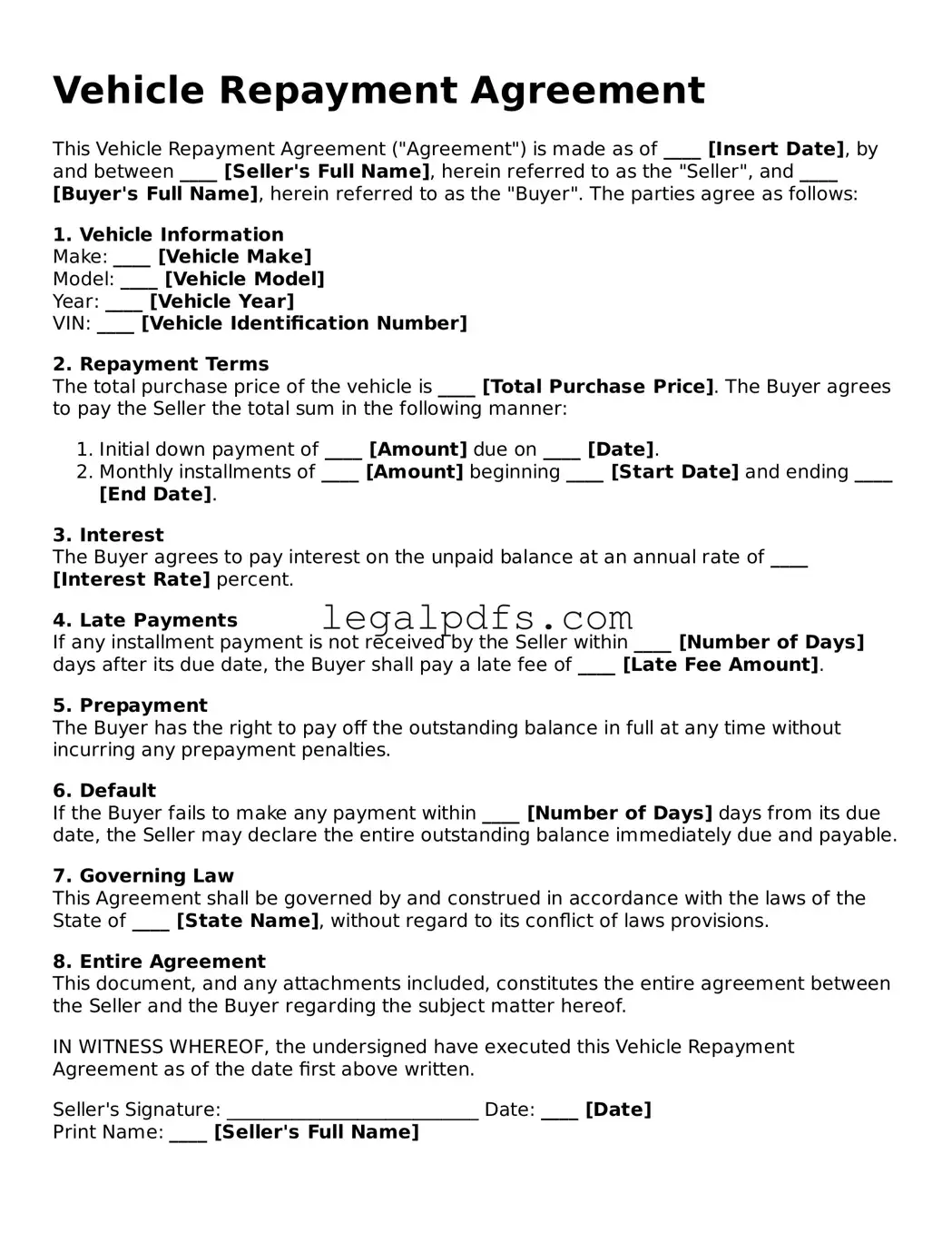What is a Vehicle Repayment Agreement?
A Vehicle Repayment Agreement is a legal contract between the seller of a vehicle and the buyer, which outlines the terms and conditions under which the buyer agrees to pay back the purchase price of the vehicle to the seller. This agreement typically includes details such as the total amount to be repaid, the schedule of payments, interest rates, and the consequences of failing to make payments as agreed.
Who needs to sign the Vehicle Repayment Agreement?
Both the seller of the vehicle and the buyer must sign the Vehicle Repayment Agreement. Their signatures legally bind them to the terms and conditions outlined in the document. In some cases, a witness or a legal representative may also be required to sign the agreement, depending on the laws of the jurisdiction where the agreement is executed.
Does the Vehicle Repayment Agreement need to be notarized?
Whether a Vehicle Repayment Agreement needs to be notarized can vary based on local and state laws. In many jurisdictions, notarization is not mandatory, but it can add a level of legal authenticity and help prevent disputes over the validity of the agreement. It's advisable to check the specific requirements in your area.
What happens if payments are not made as agreed?
If payments are not made according to the agreed-upon schedule, the seller has the right to take legal actions based on the terms specified in the Vehicle Repayment Agreement. This could include reclaiming possession of the vehicle, reporting the default to credit bureaus, or initiating a legal process to recover the owed amount. The exact consequences depend on the agreement's terms and applicable laws.
Can the payment terms be modified after the agreement is signed?
Payment terms can be modified after signing the agreement, but any changes need the consent of both the seller and the buyer. It's best to document any agreed modifications in a written amendment to the original agreement to avoid future disputes.
Is a down payment required for a Vehicle Repayment Agreement?
While a down payment is not legally required for a Vehicle Repayment Agreement, sellers often require one. A down payment can reduce the total amount financed, potentially lower the interest rate, and provide security to the seller. The requirement and amount of a down payment should be clearly specified in the agreement.
How is interest calculated in a Vehicle Repayment Agreement?
Interest in a Vehicle Repayment Agreement is typically calculated based on an annual percentage rate (APR). The method of calculation—whether simple or compound interest—should be specified in the agreement. The total interest amount reflects the cost of borrowing over the term of the loan and is influenced by the loan amount, interest rate, and payment schedule.
What personal information is needed for a Vehicle Repayment Agreement?
The agreement must include personal information for both the buyer and the seller, such as full names, addresses, and contact information. It may also require details about the vehicle, including make, model, year, VIN (Vehicle Identification Number), and current mileage, to accurately identify the subject of the agreement.
Can the Vehicle Repayment Agreement be terminated early?
Early termination of the agreement is subject to the terms laid out in the document. In many cases, early payoff may be allowed, potentially including a penalty or the waiving of remaining interest. However, specific provisions for early termination should be clearly outlined in the agreement to avoid misunderstandings.
What safeguards does a Vehicle Repayment Agreement provide?
A Vehicle Repayment Agreement provides legal protection and clarity for both the buyer and the seller. For the seller, it ensures a structured repayment plan and recourse in case of non-payment. For the buyer, it lays out the financial obligations for obtaining the vehicle and can protect against unfair practices. It serves to prevent disputes by specifying the terms of the deal in detail.
